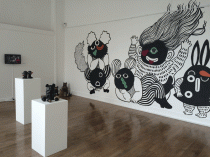I didn’t get to Venice, however I was told that the installation in the DCA wasn’t a disservice to the work … I still felt a little envious though. Crumbling grandeur in Venice to white solid painted gallery walls in Dundee, I love Dundee but my jealously is warranted.
With much planning it would still be difficult to plan an exhibition with two spaces in mind. Boyce himself said that he always understood it to be an exhibition of two parts as it didn’t make sense to make work that could fit both places.
His vision for the works started on the flight back from Venice, after seeing the 15th century Venetian Palazzo in which it was to be shown first. He saw the abandoned garden. The show also references four concrete trees created for the 1925 Exposition des Arts Decoratifs in Paris, one of Boyce’s earliest starting points.
These inverted trees form the language within the show and repeat Boyce’s early notions of ‘(the) collapse of architecture and nature’. The tree is repeated throughout creating forms and typography that become coincidental statements and letters. The graphic forest formed phrases that where notionally coming from the trees.
Boyce talked about the difficulty of working in the gallery space after the experience of the Venetian Palazzo. The walls in a gallery create a feeling that is not experienced anywhere else; you are always aware that you are in a gallery. Venice had an engineered breeze by means of windows and shutters; Dundee sees a notional breeze through the placement of ventilation grills.
Short changed? Well no, as the improvised qualities generated in the ‘enclosed’ gallery produced an exhibition that was about its objects, their placement, the space and the coincidental, which is pleasing. It echoes the involvement with Venice without feeling sickly; the garden here isn’t abandoned …..
/////
To find out what Dundee Popup was all about or to read more reviews & blogs from the day, click here.
















Comments